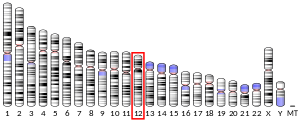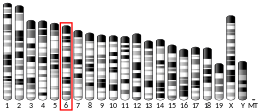OLR1
L'OLR1 (pour « Oxidized low-density lipoprotein receptor 1 »), ou LOX-1 (pour « lectin-type oxidized LDL receptor 1 ») est une protéine de type lectine C. Il s'agit d'un récepteur aux LDL oxydés. Son gène est OLR1 situé sur le chromosome 12 humain.
| OLR1 | |||||||||||||||||||||||||||||||||||||||||||||||||||
|---|---|---|---|---|---|---|---|---|---|---|---|---|---|---|---|---|---|---|---|---|---|---|---|---|---|---|---|---|---|---|---|---|---|---|---|---|---|---|---|---|---|---|---|---|---|---|---|---|---|---|---|
 | |||||||||||||||||||||||||||||||||||||||||||||||||||
| |||||||||||||||||||||||||||||||||||||||||||||||||||
| Identifiants | |||||||||||||||||||||||||||||||||||||||||||||||||||
| Aliases | OLR1 | ||||||||||||||||||||||||||||||||||||||||||||||||||
| IDs externes | OMIM: 602601 MGI: 1261434 HomoloGene: 1910 GeneCards: OLR1 | ||||||||||||||||||||||||||||||||||||||||||||||||||
| |||||||||||||||||||||||||||||||||||||||||||||||||||
| |||||||||||||||||||||||||||||||||||||||||||||||||||
| |||||||||||||||||||||||||||||||||||||||||||||||||||
| |||||||||||||||||||||||||||||||||||||||||||||||||||
| |||||||||||||||||||||||||||||||||||||||||||||||||||
| Wikidata | |||||||||||||||||||||||||||||||||||||||||||||||||||
| |||||||||||||||||||||||||||||||||||||||||||||||||||
Rôle
modifierIl interviendrait dans la genèse de l'athérome[5].
Il permet la capture, l'internalisation intra cellulaire et la dégradation des LDL oxydés[6]. Il s'agit d'un récepteur transmembranaire de 52 kD exprimé au niveau des cellules endothéliales, en particulier au niveau d'une plaque d'athérome[7]. Son expression est augmentée lors d'une inflammation[8] ou chez le diabétique[9].
Il active l'arginase II[10], l'inflammasome NLRP3[11]. Il favorise le stress oxydatif et la prolifération celluliaire intimale[12].
En médecine
modifierLors d'un syndrome coronarien aigu, son taux circulant augmente[13].
Plusieurs mutations du gènes sont corrélés avec un risque accru de maladies cardio-vasculaires, dont les accidents vasculaires cérébraux[14].
Plusieurs molécules, telles la curcumine, les flavonoïdes, l'extrait de gingko biloba, diminuent l'expression de l'OLR1 et pourraient, par ce biais, être bénéfiques[15].
Notes et références
modifier- GRCh38: Ensembl release 89: ENSG00000173391 - Ensembl, May 2017
- GRCm38: Ensembl release 89: ENSMUSG00000030162 - Ensembl, May 2017
- ↑ « Publications PubMed pour l'Homme », sur National Center for Biotechnology Information, U.S. National Library of Medicine
- ↑ « Publications PubMed pour la Souris », sur National Center for Biotechnology Information, U.S. National Library of Medicine
- ↑ Mehta JL, Sanada N, Hu CP et al. Deletion of LOX-1 reduces atherogenesis in LDLR knockout mice fed high cholesterol diet, Circ Res, 2007;100:1634–1642
- ↑ Sawamura T, Kume N, Aoyama T, et al. An endothelial receptor for oxidized low-density lipoprotein, Nature, 1997;386:73–77
- ↑ Mehta JL, Chen J, Hermonat PL, Romeo F, Novelli G, Lectin-like, oxidized low-density lipoprotein receptor-1 (LOX-1): a critical player in the development of atherosclerosis and related disorders, Cardiovasc Res, 2006;69:36–45
- ↑ Kume N, Murase T, Moriwaki H et al. Inducible expression of lectin-like oxidized LDL receptor-1 in vascular endothelial cells, Circ Res, 1998;83:322–327
- ↑ Chen M, Nagase M, Fujita T, Narumiya S, Masaki T, Sawamura T, Diabetes enhances lectin-like oxidized LDL receptor-1 (LOX-1) expression in the vascular endothelium: possible role of LOX-1 ligand and AGE, Biochem Biophys Res Commun, 2001;287:962–968
- ↑ Ryoo S, Bhunia A, Chang F, Shoukas A, Berkowitz DE, Romer LH, OxLDL-dependent activation of arginase II is dependent on the LOX-1 receptor and downstream RhoA signaling, Atherosclerosis, 2011;214:279–287
- ↑ Ding Z, Liu S, Wang X et al. LOX-1, mtDNA damage, and NLRP3 inflammasome activation in macrophages: implications in atherogenesis, Cardiovasc Res, 2014;103:619–628
- ↑ Hinagata J, Kakutani M, Fujii T et al. Oxidized LDL receptor LOX-1 is involved in neointimal hyperplasia after balloon arterial injury in a rat model, Cardiovasc Res, 2006;69:263–271
- ↑ Hayashida K, Kume N, Murase T et al. Serum soluble lectin-like oxidized low-density lipoprotein receptor-1 levels are elevated in acute coronary syndrome: a novel marker for early diagnosis, Circulation, 2005;112:812–818
- ↑ Au A, Griffiths LR, Cheng KK, Wee Kooi C, Irene L, Keat Wei L, The influence of OLR1 and PCSK9 gene polymorphisms on ischemic stroke: evidence from a meta-analysis, Sci Rep, 2015;5:18224
- ↑ Pothineni NV, Karathanasis SK, Ding Z, Arulandu A, Varughese KI, Mehta JL, LOX-1 in atherosclerosis and myocardial ischemia: biology, genetics, and modulation, J Am Coll Cardio, 2017;69:2759-2768




